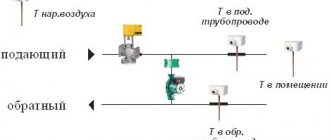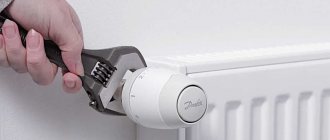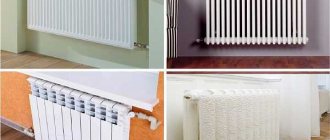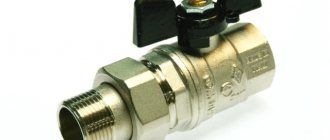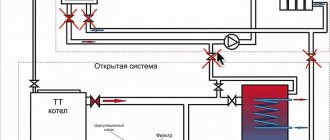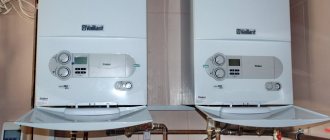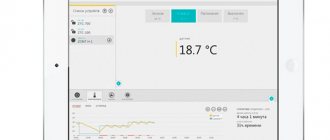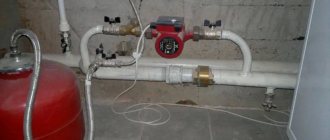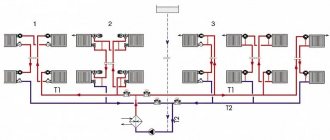How to properly regulate the temperature of a radiator, manually or automatically
Adjusting heating radiators in an apartment allows you to simultaneously solve several problems, the main one of which is to reduce the cost of paying for certain utilities. This possibility is realized in different ways: mechanically and automatically. However, when changing the heating system parameters, the average room temperature does not increase. You can only reduce it to the desired level by adjusting the position of the fittings. It is advisable to install such devices on batteries in houses where it is cool in winter.
Why do you need to make adjustments?
The main factors explaining the need to change the heating level of batteries using locking mechanisms and electronics:
- Free movement of hot water through pipes and inside radiators. Air pockets may form in the heating system. For this reason, the coolant stops heating the batteries, as it gradually cools. As a result, the indoor microclimate becomes less comfortable, and over time the room cools down. To maintain heat in the pipes, shut-off mechanisms installed on radiators are used.
- Adjusting the temperature of the batteries makes it possible to reduce the cost of heating your home. If the rooms are too hot, by changing the position of the valves on the radiators you can reduce costs by 25%. Moreover, reducing the heating temperature of the batteries by 1°C provides savings of 6%.
- In cases where radiators heat up the air in the apartment very much, you have to open the windows often. It is not advisable to do this in winter, because you can catch a cold. To avoid having to constantly open windows in order to normalize the microclimate in the room, regulators should be installed on the batteries.
- It becomes possible to change the heating temperature of radiators at your discretion, and individual parameters are set in each room.
Why is the riser hot and the batteries cold?
Sometimes, with a hot supply, the return of the heating battery still remains cold. There are several main reasons for this:
- installation was performed incorrectly;
- the system or one of the risers of a separate radiator is airborne;
- insufficient fluid flow;
- the cross-section of the pipe through which the coolant is supplied has decreased;
- The heating circuit is dirty.
Cold return is a serious problem that must be eliminated. It entails many unpleasant consequences: the temperature in the room does not reach the desired level, the efficiency of radiators decreases, and there is no way to correct the situation with additional devices. As a result, the heating system does not work as it should.
The main trouble with cold return is the large temperature difference that occurs between the supply and return temperatures. In this case, condensation appears on the walls of the boiler, reacting with carbon dioxide, which is released during fuel combustion. As a result, acid is formed, which corrodes the walls of the boiler and shortens its service life.
Adjusting heating appliances depending on the type of heating system
Before regulating the heating in an apartment, it is necessary to determine the type of heating system used.
Individual heating
In this case, the procedure is much simpler, since in most cases the systems are powered by a powerful heating boiler, in addition, a circulation pump is installed, and each heating device has a three-way valve.
The presence of valves on radiators allows rational use of heat by reducing the water supply to the radiator or completely disconnecting it from the system.
Central heating
In a central heating system, the question of how to adjust the heating battery in an apartment is decided depending on the pipe layout:
- With a two-pipe wiring diagram, two risers are installed, which ensure the supply of coolant to the heating devices and its return. The flow of hot water in the radiator is regulated by means of a separate valve and a manual or automatic thermostat, which is equipped with each heating device.
- The operating principle of a single-pipe system is to supply coolant to each radiator and return it to the main riser. Thanks to this scheme, the water temperature in heating devices on any floor is almost the same. Each heating device has a control valve on the supply side.
- Most multi-storey buildings have a heating system with vertical supply of coolant, which completely eliminates the possibility of adjusting the temperature in heating devices. With this scheme, the radiators on the lower floors heat up very poorly, so the apartments are always cold. The rooms on the upper floors, on the contrary, suffer from the heat.
How radiator thermostats help save heat
New tariffs for housing and communal services force every Ukrainian to seriously think about the economical use of all types of resources and, first of all, about saving thermal energy. Tariffs for heat are off the charts and are many times higher than tariffs for electricity, water and even gas.
Speaking about saving any type of resources, it should be borne in mind that they can be saved only if one mandatory condition is met: the presence of consumption accounting and the ability to regulate this consumption. For example, you installed a heat meter in your apartment, but did not install radiator thermostats on your heating appliances. With this option, you will know exactly the amount of heat consumed, but we will not be able to influence the reduction of its consumption in any way - there is no element of regulation. True, payment for consumed energy will be based on real consumption, and not on average per square meter. And vice versa, you have installed thermostats, but accounting is not organized. This option only provides the opportunity to regulate the thermal comfort in the apartment, and payment for consumed heat will be made by square meters. In both the first and second cases, you will not be able to get the desired cost savings for the consumed thermal energy. Only unity of accounting and regulation provide such an opportunity.
The main element that allows for metering of consumed thermal energy is a heat meter. Today, the market offers a large number of models of heat meters of domestic and foreign production, both for organizing apartment-by-apartment and general-building accounting. Of course, apartment accounting is a priority, but, unfortunately, in most existing buildings it is very difficult to organize it due to the specifics of intra-house heating networks, which were mainly carried out according to vertical schemes with upper or lower wiring. Therefore, it is impossible to organize apartment-by-apartment accounting here, and installing a heat meter on each heating device is very expensive and not advisable. In this case, it is more rational to organize a general house metering of thermal energy consumption. In new buildings built according to modern building codes, systems with horizontal wiring are used, which provide apartment-by-apartment heat inputs and are adapted for the installation of apartment-by-apartment meters.
Another important element that represents the possibility of saving thermal energy is the radiator thermostat. It was invented in 1943 by Danish engineer Meds Clausen, founder of Danfoss A/S. The main element of the thermostat is a bellows - a sealed container with corrugated movable walls, filled with a heat-sensitive substance. Reacting to changes in temperature in the room, the bellows, increasing or decreasing in volume, moves the rod, which controls the valve that regulates the supply of coolant to the heating device. Using a radiator thermostat, you can set the desired temperature in the room in the range from 5 to 26°C.
The thermostat valve is mounted on the supply pipe directly in front of the heating device. The thermostatic element (called the “head”) is attached to the valve body using an integrated connection mechanism without the use of any tools.
There are several types of thermostatic elements:
1.
Thermostatic elements with built-in sensor. This is the most common type of thermostatic element. They should always be positioned horizontally to allow ambient air to circulate freely around the sensor.
2.
Thermostatic elements with remote sensor. They are mainly used in cases where the thermostatic element is covered with thick curtains or a protective screen, which can distort data on the actual temperature in the room. The remote sensor must be installed on an open surface at a distance of up to 2 meters from the thermostatic element.
3.
Thermostatic elements with remote regulator. They are used in cases where access to the adjusting head is difficult, for example, when it is covered with non-removable decorative panels.
Setting the desired temperature in the room is carried out by turning the handle of the thermostatic element with a setting scale printed on it. The setting scale has the following designations, which correspond to a certain temperature range: “asterisk” – setting to protect the coolant from freezing (7.5-9.5 ° C), 1 – (13-14 ° C), 2 – (15-17 °C), 3 – (18-20°C), 4 – (21-23°C) and 5 – (24-25°C). Depending on the selected position, the radiator thermostat will constantly maintain the set temperature in the room. Unfortunately, this is how most consumers use the ability to regulate heat consumption in their apartments. They set a temperature that is comfortable for themselves and forget about the available opportunities to save thermal energy through regulation. And these opportunities are quite significant. As practice shows, through the rational use of radiator thermostats, you can actually save up to 20% of heating energy. And the rules here are not complicated. First of all, it is necessary to determine the optimal temperature regime for each room in the apartment. It is not at all necessary to maintain the temperature in all rooms at 20-25°C. For example, in a kitchen where heat-producing appliances and equipment operate (stove, refrigerator, microwave, etc.), the temperature can be set a little lower. The same applies to bedrooms. Further, if residents leave the premises for some time (go to work, classes), then the temperature in the apartment premises can be significantly reduced, and after arrival it can be quickly brought to the required parameters. Even greater savings can be achieved if, during a period of long absence of residents (winter vacation), the radiator thermostats in the apartment are set to the function of protecting the coolant from freezing. These rather simple actions can significantly save thermal energy.
Ball valve
This is the most famous type of shut-off valve. Inside it there is a smooth ball that has a through hole and is capable of rotating 90°C, thus regulating the flow of water in the pipe, closing or opening it. The design of the mechanism provides it with minimal resistance to flow when open. It is designed to operate in the fully open or fully closed position to quickly shut off the water or, in some cases, drain it. Intermediate provisions are possible, but prohibited.
The materials for these mechanisms will be nickel-plated brass and stainless steel; for metal-plastic systems, polymer materials are also used. There are expensive and high-quality cranes from the Danfoss, Giacomini, and Bugatti brands on the market. For limited financial capabilities, Chinese and Turkish Valtec and Fado are offered. Good quality at a low price is offered by the Chinese AGUA-WORID.
The most common type of tap is a valve. Allows you to regulate the pressure. The flow channel inside it is perpendicular to the flow of liquid in the supply pipes. Installation must be carried out with careful attention to the markings so that water flows only in one direction.
For heating systems there are valves with a conical valve. They are most effective for such conditions. Fully open, it allows the maximum amount of liquid to pass through, which makes the thermal output of the battery more efficient. The mechanism allows you to reduce the flow of coolant and reduce heat transfer if the room is too hot and, thus, control the temperature.
There are these types:
- adjusting (straight and angular). They have manual control. Used in autonomous heating. They cannot accurately adjust heat transfer due to the lack of a scale and temperature sensor;
- equipped with a thermal head. Their design allows the temperature rise to be blocked or limited through manual or automatic control. Installed on two- and one-pipe systems. Adjustment is simple - the required temperature is set manually using a limit ring;
- with thermostat. Installed in front of the battery. The flow of coolant is controlled by a tap mounted in front of the thermostat.
There are no valve taps made of plastic; they are made from brass, steel or a combination of these materials.
Setting the return and supply temperatures in an apartment building
The installation of the heating system regulator will depend on its overall design . If the CO is installed individually for a specific room, the improvement process takes place due to the following factors:
- the system operates from an individual boiler ;
- a special three-way valve was installed ;
- The coolant is forcibly .
In general, for all COs, power regulation work will consist of installing a special valve on the battery itself.
With its help, you can not only regulate the heat level in the necessary rooms, but also eliminate the heating process altogether in those areas that are poorly used or do not function.
There are the following nuances in the process of adjusting the heat level:
- Central heating systems, which are installed in multi-storey buildings , are often based on coolants, where the supply occurs strictly vertically from top to bottom. In such houses, it is hot on the upper floors and cold on the lower floors, so it will not be possible to adjust the heating level accordingly.
- If houses use a single-pipe network , then heat from the central riser is supplied to each battery and returned back, which ensures uniform heat on all floors of the building. In such cases, it is easier to install heat control valves - the installation takes place on the supply pipe and the heat continues to spread evenly.
- For a two-pipe system, two risers are already installed - heat is supplied to the radiator and in the opposite direction, respectively, the adjustment valve can be installed in two places - on each of the radiators.
Types of Battery Control Valves
Modern technologies are far from standing still and make it possible to install a high-quality and reliable faucet , which will control the level of heat and heating. It is connected to the battery with special pipes, which does not take much time.
Based on the types of adjustment, I distinguish two types of valves :
- Conventional thermostats with direct action. Installed next to the radiator, it is a small cylinder, inside of which a siphon based on liquid or gas , which quickly and competently responds to any temperature changes. If the temperature of the battery rises, the liquid or gas in such a valve expands, causing pressure on valve stem , which will move and block the flow. Accordingly, if the temperature drops, the process will be reversed.
Photo 1. Diagram of the internal structure of the thermostat for the battery. The main parts of the mechanism are indicated.
- Thermostats based on electronic sensors. The principle of operation is similar to conventional regulators, only the settings differ - everything can be done not manually, but electronically - set the functions in advance, with a possible time delay and temperature control.
How to adjust heating radiators
The standard process for regulating the temperature of heating radiators consists of four stages - bleeding air, adjusting pressure, opening valves and pumping coolant.
- Bleeding air . Each radiator has a special valve, by opening which you can release excess air and steam that interferes with the heating of the battery. Within half an hour after this procedure, the required heating temperature must be reached.
- Pressure adjustment . To ensure that the pressure in the CO is distributed evenly, you can turn the shut-off valves of different batteries attached to the same heating boiler to different numbers of revolutions. This adjustment of the radiators will allow you to heat the room as quickly as possible.
- Opening valves . Installing special three-way valves on radiators will allow you to remove heat from unused rooms or limit heating, for example, while you are away from the apartment during the day. It is enough to simply close the valve completely or partially.
Photo 2. Three-way valve with thermostat, allowing you to easily adjust the temperature of the heating radiator.
- Coolant pumping. If the CO is forced, the coolant is pumped using control valves, with the help of which a certain amount of water is drained to give the heating radiator the opportunity to heat up.
Heating temperature control
An important parameter of any heating system is the optimal temperature regime for its operation. A ratio of hot and cooled coolant of 75/50 or 80/60 is considered suitable. However, this value is not always acceptable for certain parts of the network. How to properly adjust the heating in the house in this case? Installation of special equipment is required. Some of them are designed for adjusting heating radiators.
Mixing units
Their main element is a two or three-way valve. One of the pipes is connected to the heating pipe with hot water, the second to the return pipe. The third is mounted on a section of the main line where it is necessary to ensure a lower level of coolant temperature.
As additional options, the mixing units are equipped with a temperature sensor and a thermostatic control unit. A signal is received from the sensor about the heating level of the coolant and it opens or closes the mixing valve, thereby regulating the two-pipe heating system. Most often, such mechanisms are installed in water-heated floor collectors.
If you need to adjust the heating of a water heated floor in an apartment building, you need to take into account the temperature conditions of the pipes. Most often it does not exceed 45 degrees.
Servo drives
Servo drive for radiators
How to adjust the heating in an apartment building if it is not possible to independently change the temperature of the water in the pipes? This requires the installation of special shut-off valves. You can limit yourself to installing simple taps - with their help, the flow of coolant into the radiators is regulated. However, in this case, the adjustment will have to be done independently each time. The best option would be to install servos.
The design of this device includes a thermostat and a servo drive. To work, you must perform the following steps.
- Set the desired temperature value on the thermostat.
- The servo drive will automatically open or close the flow of coolant into the radiator.
In addition to similar models, you can purchase an economy version that includes only a thermostat. In this case, the level of adjustment will not be as accurate. But how to adjust the heating system in an apartment building if old radiators are installed? There are models of thermostats that are designed for installation in cast iron radiators. This measure will make the temperature settings for the apartment more accurate.
Thermostats cannot be used to regulate the pressure drop in the heating system. They will only limit the flow of coolant into the radiator without affecting the temperature regime of the entire system.
Automatic adjustment
The advantage of this method is that there is no need to constantly change the position of the valve/faucet. The desired temperature will be maintained automatically. Adjusting the heating in this way makes it possible to set the desired parameters once. In the future, the heating level of the battery will be maintained by an automation unit or other device installed at the input of the heating device.
If necessary, individual parameters can be set multiple times, which is influenced by the personal preferences of the residents. The disadvantages of this method include the significant cost of components. The more functional the devices are for controlling the amount of coolant in heating radiators, the higher their price.
Electronic thermostats
These devices superficially resemble a control valve, but there is a significant difference - a display is built into the design. It displays the room temperature that needs to be obtained. Such devices work in conjunction with a remote temperature sensor. It transmits information to the electronic thermostat. To normalize the microclimate in the room, you just need to set the desired temperature value on the device, and the adjustment will be performed automatically. Electronic thermostats are located at the battery input.
Adjusting radiators with thermostats
Devices of this type consist of two units: lower (thermal valve) and upper (thermal head). The first of the elements resembles a manual valve. It is made of durable metal. The advantage of such an element is the ability to install not only an automatic, but also a mechanical valve, it all depends on the needs of the user. To change the heating temperature of the battery, the design of the thermostat provides a bellows, which exerts pressure on the spring-loaded mechanism, and the latter, in turn, changes the flow area.
Locking devices
The taps used for installation in the room heating system should be divided into two groups - shut-off and control. This division is largely arbitrary, since shut-off valves also allow you to regulate the movement of the coolant. Naturally, in this case the adjustment accuracy is quite low, but it is possible to cut off the battery from the water source.
Ball design diagram
The simplest and most commonly used type of valves are ball valves:
The ball valve is designed to shut off the radiator. Its design allows the device to be installed in either an open or closed position, so that the adjustment is carried out quite according to the principle “there is heat - there is no heat.”
Ball valves for heating radiators provide two-position adjustment
Note! In principle, it is possible to fix the valve in an intermediate position, but then the rate of its wear will increase many times due to the friction of particles suspended in water against the shut-off element. So it's better not to do this unless absolutely necessary.
- The coolant flow is blocked by the movement of a metal ball with a hole coaxial with the pipe clearance. When you turn the faucet handle, the rod comes into action, which rotates the sphere inside the body, aligning the hole in it with the lumen of the pipe.
- As a rule, faucet parts are made of steel, bronze or brass. PTFE gaskets are responsible for sealing the connections and the locking part, which, if necessary, can be replaced with your own hands.
- Connection to the radiator is carried out either using a regular nut or using an “American” one.
Ball design with American
Unlike ball valves, cone valves make it possible to regulate the coolant flow more smoothly. This is ensured by the features of their design:
Sectional view of the device
- The locking element is a conical rod, on the surface of which a thread is applied.
- When we rotate the flywheel, the rod moves along the thread, moving in a vertical plane.
- In the lowest position, the pipe lumen is completely blocked. The tightness of the overlap is ensured by elastic gaskets that fit onto the annular grooves of the rod.
- By lifting the locking part, we open the gap slightly, and the coolant begins to flow into the radiator.
Note! The microclimate in the room can be adjusted only approximately by decreasing or increasing the amount of hot water in each battery
Model in polypropylene case
In practice, bronze or brass cone valves for heating radiators are most often used: only systems are equipped with polypropylene, some of the pipes in which are also made of plastic. This is explained by the relatively low strength and wear resistance of polymers compared to sanitary alloys.
On the other hand, polypropylene taps for heating radiators are somewhat cheaper, so in conditions of budget deficit they can be used.
Mayevsky crane
When you pour coolant into the heating system, air gets inside along with water or antifreeze.
To remove it, special devices are used - the so-called Mayevsky taps:
Air release device
- The design of such a product is quite simple: it is based on a shut-off rod installed in a housing with a thread for the radiator plug.
- The rod is driven either by a screwdriver or a special wrench, opening the lumen of the pipe in the saddle.
Note! If possible, buy valves for a screwdriver, since you will regularly lose the key, which is not surprising - you will have to use it once or twice a year. You need to keep in mind that the throughput of such a faucet is small, so, for example, you shouldn’t install it on an expansion tank: it will take about an hour to bleed off excess air
In such a situation, a regular valve or a water tap installed with the spout facing up is more suitable.
You need to keep in mind that the throughput of such a faucet is small, so, for example, you shouldn’t install it on an expansion tank: it will take about an hour to bleed off excess air. In such a situation, a regular valve or a water tap installed with the spout facing up is more suitable.
Photo of the installed valve
Heating adjustment work using shut-off valves
Throughout the entire process, the water entering the system must have a constant temperature. Adjustment is usually made according to temperature changes by changing the volume of supplied water, which depends on the type of heating system and thermal input.
Temperature changes depend on the volume of water consumed and this value is inversely proportional. Thus, in order to increase the difference to the required value, the coolant flow should be reduced. To do this, either close the valve located at the inlet or reduce the flow itself.
The more water passes through heating devices, the higher the speed of its movement and, accordingly, the coolant cools less. As a result, the average temperature in the radiator increases and the heat transfer of the device increases. After completing the adjustment in the heating unit, individual risers of the structure are subject to adjustment. If problems arise, repairs are carried out in such a way that it is possible to use control valves for the heating system on risers or balancing valves (more details: “Regulation valves for heating radiators, valve installation”).
One way to adjust the heating system is shown in the video:
When there are only taps on the heating risers, only preliminary adjustments are made. It should be taken into account that the closer the riser is to the inlet, the more the tap should be opened. This is necessary so that the heating shut-off valves on the closest riser allow a minimum volume of water to pass through.
At the same time, on the riser located farthest away, you need to open the tap, such as in the photo. First, they check the quality of heating of the furthest riser and finish with the one that is closest.
Typically, in two-pipe systems, due to pressure, devices on the upper floors overheat. If this deficiency is not present on the lower floor, then adjustment of the upper heating radiators is necessary. If there is a double adjustment valve, it is possible to reduce the flow area. In the absence of such taps, the heating radiators are adjusted by installing throttle washers.
In two-pipe heating systems, the uniformity of heating of radiators will increase with increasing water flow. The most important parameter for heating structures is operating pressure (read: “Losses and pressure drop in the heating system - solving the problem”). To lower it, use a pressure regulator in the heating system, and to increase it, use circulation pumps.
The temperature of the coolant when adjusting the device cannot exceed 50-60 °C. After completing the adjustment, the water temperature must be brought to 90 °C, and the heatability of the radiators must be checked again at this temperature. It is advisable to seek the services of specialists to adjust heating systems.
Manual regulators
Manual adjustment is made by a valve installed on the pipes supplying or discharging the coolant from the battery. The diagram, depending on the type of heating system (two-pipe or single-pipe), is slightly different:
Everything is simple here, it gets hot - close the valve, cold - open it.
The radiator is additionally equipped with another valve so that if a leak appears on the radiator, it can be repaired or the radiator can be replaced without shutting down the entire system.
How not to regulate the radiator temperature
Perhaps we need to focus your attention on one important thing. That to adjust radiators you need to install valves, not ball valves
Often, two ball valves are installed on radiators in case of emergency situations when this area requires urgent repairs. These taps make it possible to carry out repairs without draining the heating system or shutting off the common riser of the house. Some regulate batteries with them. This is not worth doing.
Ball valves are shut-off valves; they have only two operating positions, open or closed. It does not have any intermediate working positions. Yes, it will reduce the rate of coolant passing through the radiator as much as you need it. But his days will be numbered. The fact is that when the position of this tap is between “open” and “closed”, the ball, covered with a protective layer, begins to be destroyed by small particles in the form of sand, scale, rust, located in the coolant. Especially in central heating coolant. In places where the layer is damaged, lime deposits, rust, etc. begin to be deposited.
As a result, the faucet handle and the ball first stop spinning, and then begin to leak altogether. Which will lead to a situation where it will be necessary to drain all the water from the heating system and shut off the riser of the house, because the tap that was designed for this no longer works.
Which valves to use for adjustment
To regulate the temperature of heating radiators, special radiator control valves are used. They are specifically designed for use in heating systems, both individual and central. They are resistant to coolant containing solid particles and are also capable of high throughput. They exist with both direct and angular connections.
These valves are reliable, durable, affordable, and effectively cope with their intended purpose. The only disadvantage of manual regulators is periodic monitoring and adjustment. You have to tighten it from time to time, sometimes to a greater or lesser degree, depending on the climate outside, the temperature of the coolant and the room.
Coordination of coolant and boiler temperatures
Regulators help coordinate the temperature of the coolant and the boiler. These are devices that create automatic control and adjustment of return and supply temperatures.
The return temperature depends on the amount of liquid passing through it. Regulators cover the liquid supply and increase the difference between the return and supply to the level required, and the necessary indicators are installed on the sensor.
If the flow needs to be increased, a boost pump can be added to the network, which is controlled by a regulator. To reduce the heating of the supply, a “cold start” is used: that part of the liquid that has passed through the network is again transported from the return to the inlet.
The regulator redistributes the supply and return flows according to the data collected by the sensor, and ensures strict temperature standards for the heating network.
Differences in heating systems
Depending on their location, there are three types of heating systems:
- systems through which water moves from top to bottom;
- single pipe system;
- two-pipe system.
If your home has a system of the first type, then it will simply be impossible to adjust the temperature of the heating radiator. On the upper floors the radiators will be constantly hot, but on the lower floors they will be colder.
If you have a flow-through single-pipe system, then to adjust the heating radiators it will be enough to install an additional valve on the pipe that supplies hot water to a separate radiator. In a flow-through system, water moves through the riser, passes through the battery and returns to it again. (See also: What good heating radiators can be used to heat residential premises)
If there is a two-pipe system, both manual valves and special automated devices can be installed on the main line. They help regulate not only the temperature, but also the volume of incoming water. Which device to choose - manual or automatic - is up to you.
Recommendations for installing devices
To be able to regulate the temperature of the battery in the apartment, consider any type of valve: they can be straight or angular. The installation principle of such a device is simple; the main thing is to correctly determine its position. Thus, the direction of coolant flow is indicated on the valve body. It must correspond to the direction of water movement inside the battery.
Place valves/thermostats at the inlet of the heating device; if necessary, install a tap at the outlet as well. This is done so that in the future it will be possible to independently drain the coolant. Regulating devices are installed on heating radiators, provided that the user knows exactly which pipe is the supply pipe, since a tap is made into it. In this case, the direction of movement of hot water in the riser is taken into account: from top to bottom or from bottom to top.
Compression fittings are more reliable, which is why they are used more often. The connection to the pipes is threaded. Thermostats can be equipped with a union nut. To seal the threaded connection, use FUM tape or flax.
If the individual heating system is designed correctly, no regulators will be needed: a stable temperature will be maintained in each room. But in multi-storey buildings after complete heating alterations, regulators can become very useful.
It is necessary to regulate the heat transfer of heating radiators for several reasons. First: it allows you to save on heating costs. In apartments in multi-storey buildings, payment bills will be reduced only if a common building heat meter is installed. In private homes, if you have an automated boiler that itself maintains a stable temperature, you are unlikely to need regulators for radiators. Unless you have old equipment. Then the savings will be quite significant.
Manual regulators on radiators
The second reason why regulators are installed on heating radiators is the ability to maintain the temperature in the room that you want. You need +17 o C in one room, and +26 o C in the other, set the appropriate values on the thermal head or close the valve, and you have as warm air as you want. It doesn’t matter whether you have radiators in your apartment, whether the coolant is supplied centrally, or whether the heating is individual. And it doesn’t matter at all what type of boiler is in the system. Radiator regulators are not connected in any way to boilers. They work on their own
Why do you need to regulate heating batteries?
Firstly, adjusting the temperature helps create the most comfortable indoor conditions.
Secondly, this reduces heat consumption costs. If we calculate the efficiency of heating radiator regulation systems, then on average costs are reduced by 25%.
Thirdly, if you have heat consumption meters, you can control the cost of heating the room.
Fourthly, there is no need for constantly open windows. Of course, fresh air is useful, but if there are small children or sick people in the room, a draft can only harm them.
Start adjusting the batteries in advance, before the start of the new heating season, and then during the cold season you will not have to freeze and try to frantically adjust the central heating system. However, you shouldn’t do this in the summer either - while it’s hot outside, you won’t be able to fully appreciate the comfort of artificially heated air and correctly set the required temperature.
The need to adjust the temperature before the start of the season. If the apartment or house is too cold for comfortable living, you will have to change the heating settings. The problem usually concerns both apartment buildings with a centralized heating system, and private ones with an individual heating system.
The temperature can only be reduced compared to the original value, and also carried out separate adjustments for different rooms. For example, if the bedroom is too warm, you need to reduce the setting. Otherwise, you may have problems sleeping. For this reason, it is required during design and calculations. If the system has already been installed, then modifications will need to be made.
Work process
Results
Adjusting heating radiators is possible using different devices, but this must be done correctly using special control valves. These are manual regulators (taps) and automated ones - thermostats; in some versions it is possible to use a three-way valve with a thermal head.
In what case should I use what? In multi-storey apartments with central heating, a three-way valve and control taps are preferable. And all because the gap in thermostats for the coolant is not very wide, and if there are foreign particles in the coolant, it quickly becomes clogged. Therefore, they are recommended for use in individual heating systems.
If you really want automatic radiator control in your apartment, you can install a filter before the thermostat. It will retain most of the impurities, but you will have to wash it regularly. When you feel that the radiator has become too cold, check the filter.
In private houses, with battery regulation, everything is simple: what suits you best, then install it.
In apartments or private houses, residents often encounter the phenomenon of uneven heating of heating radiators in different parts of the home. Such situations are typical in cases where the premises are connected to autonomous heating systems.
How to optimize the heating system (HC), stop overpaying and how installing a heat regulator for batteries will help - we will consider further.
Radiator temperature
Very often, residents of apartment buildings and country houses wonder what temperature the heaters themselves should be in the room according to the standard and how to properly adjust the heating radiators. In fact, there is no such standard for the temperature of radiators. There is only such a thing as heat transfer. It completely depends on what material the radiator is made of. Aluminum radiators are considered the most effective for quickly warming up a room, bimetallic ones transfer heat a little worse, and cast iron ones are in last place. (See also: Steel heating radiators)
Instead of standards for the temperature of heating units, there are standards for the level of air heat in rooms. According to these standards, the temperature in living rooms should be no lower than 18C and no higher than 24C. In other rooms (toilet, bathroom, kitchen, hallway, storage room) it should be from 14 to 22C. The ideal temperature is considered to be 21C. if you manage to achieve uniform heat distribution throughout the entire area of the apartment or house, this will be the best option of all possible.
Why do you need heat regulation in an apartment?
For what reasons do citizens more often adjust the heat in their residential premises:
- There is living conditions in the house
- It is necessary to get rid of excess air in the batteries, to achieve effective heat transfer in the interior.
- Timely installation of regulators allows you to refrain from frequent ventilation when the air is overheated using open windows.
- Correctly selected heating regulators and their proper use will reduce the amount of payments for this service by a quarter.
Important! Installation of the CO regulator should be carried out before the start of the heating season. In the midst of frost, such a procedure will require turning off not only the heating in your own apartment, but also in the neighboring ones, which will create certain inconveniences.
Manual valves
Manually adjustable valves allow you to change the volume of coolant entering the radiator by increasing or decreasing the diameter of the passage hole.
The valve includes a valve with a shut-off head. It, in turn, is connected to a handle, on which a scale with divisions can be applied. Turning the handle causes the shut-off head to move and the volume of incoming coolant to change to a smaller or larger direction. The marks on the scale allow you to set the required battery temperature.
Manual valves are simple, reliable and inexpensive, but require regular monitoring.
Stabilization of pressure in the heating system
Expansion of water as a result of heating is a natural process. In this indicator, the pressure may exceed a critical value, which is unacceptable from the point of view of heating operation. In order to stabilize and reduce pressure on the internal surfaces of pipes and radiators, it is necessary to install several heating elements. Adjusting the heating system in a private home will be much easier and more efficient with their help.
Adjusting the expansion tank
Expansion membrane tank
It is a steel container divided into two chambers. One of them is filled with water from the system, and air is pumped into the second. The air pressure value is equal to normal in heating pipes. If this parameter is exceeded, the elastic membrane increases the volume of the water chamber, thereby compensating for the thermal expansion of water.
Before adjusting the pressure drop in the heating system, you need to check the condition and settings of the expansion tank. You can adjust the pressure in the heating system by purchasing a tank model with the ability to change it in the air chamber. As an additional measure, install a pressure gauge to visually monitor this value.
However, if there is a significant surge in pressure, this measure will not be enough. This way you can adjust the pressure drop in the heating system if it does not exceed a critical value. Therefore, it is recommended to install additional devices.
How to adjust a security group
Heating safety group
This group of devices includes the following elements:
- Pressure gauge. Designed for visual monitoring of the heating system operation;
- Air vent. If the water temperature exceeds 100 degrees, excess steam acts on the valve seat of the device, releasing air from the pipes;
- Safety valve. It works in the same way as a water drain, but is needed to drain excess coolant from the pipes.
How to adjust a heating radiator using this unit? Alas, it is designed to prevent emergency situations throughout the entire system. Batteries require another device to be installed.
Mayevsky crane
Structurally, it is similar to a safety valve. A special feature is its small size and the ability to be mounted on a radiator pipe with a small diameter.
In order to correctly adjust heating radiators, you need to know in what cases the Mayevsky tap is used:
- Eliminating air pockets in radiators. By opening the valve, air is released until the coolant flows;
- Setting the critical pressure value parameters. If an emergency expansion of water occurs, the valve opens and the pressure in the radiator stabilizes.
Design of the Mayevsky crane
The last function is optional and is most often not used. This task is best handled by the security team. Proper adjustment of heating in the house should include all of the above elements.
When independently regulating a two-pipe heating system while the boiler is running, you need to constantly monitor the readings of thermometers and pressure gauges.
Video description
How to reduce battery heat dissipation
Contact utility companies
Problems in high-rise buildings are resolved by the management company. According to the rules, residents should not directly contact workers servicing the heating network. It is better for the inhabitants of the problem apartment to write a statement to the Criminal Code. If the complaint is not considered, then they further contact Rospotrebnadzor and the housing inspectorate.
The appeal will be investigated if the problem of too high a temperature is observed in other residents. In high-rise buildings, people on the lower floors often suffer from the heat, while those on the upper floors freeze. Utility workers turn up the heating as much as possible, which leads to discomfort.
The management company must carry out balancing. After correction, the temperature of all residents should return to normal. If the weather forecast predicts a sharp cold snap in the coming days, workers may ignore the request.
How to increase the output power of a radiator
The output power of radiators can only be increased by increasing the temperature of the coolant. Or changing radiators to more efficient ones (replacing old, clogged, cast-iron ones with modern bimetallic, aluminum, steel, etc.). Replacing the radiator supply pipes with new ones, adding additional sections to the installed batteries and a number of other factors influencing this. Even the way the radiator is connected to the heating system will depend on its temperature.
Therefore, from the above, it becomes clear that, for example, if in your apartment, which has centralized heating, the radiators do not fully cope with their task, then it will not be possible for you to raise the temperature of the coolant, since you are not doing this and cannot do this
Therefore, it is better to pay attention to the quality of the radiators themselves or, for example, to the insulation of windows and the entire apartment as a whole. Perhaps it would be more rational to invest money in, say, new double-glazed windows
In a private house with individual heating, please regulate the water temperature in the system with a heating boiler, but again, the quality of home insulation is a fundamental factor in a warm home. Perhaps your heating system is normal and by adding a boiler, you will spend money on energy resources.
Step-by-step instructions for adjusting temperature
To ensure comfortable living conditions in the room, you need to perform some basic steps.
Connection diagrams
- Initially, it is necessary to bleed the air on each battery until water flows from the tap in a trickle.
- Then you need to adjust the pressure in the batteries.
- To do this, in the first battery from the boiler you need to open the valve by two turns, on the second - by three, and then according to the same scheme, increasing the number of turns of the valve being opened on each radiator. Thus, the coolant pressure will be evenly distributed over all radiators. This will ensure its normal passage through the pipes and better heating of the batteries.
- In a forced heating system, control valves will help to pump the coolant and control rational heat consumption.
- In a flow-through system, the temperature is well regulated by thermostats built into each battery.
- In a two-pipe heating system, you can control not only the temperature of the coolant, but also its quantity in the batteries using both manual and automatic control systems.
Control valves
Operating principle
A control valve for a heating radiator is a device that allows you to automatically control the movement of the coolant.
The design of such products is quite complex, but they also work much more efficiently than valves for manual adjustment:
The bellows, a container filled with liquid or gas, is responsible for sensing the outside temperature. As the temperature rises, the bellows expands, affecting the control unit.
Note! The price of liquid and gas-filled devices is approximately the same, but the operating features are different. Thus, gas models react faster to temperature changes, while liquid models more accurately convey the impact on the coolant flow
- The expanded bellows presses on the valve stem, which lowers and gradually closes the valve saddle, through which hot water enters the battery.
- When cooling, the opposite situation is observed: the rod rises and the lumen of the saddle expands.
We set the degree of initial compression of the bellows ourselves, either by setting the temperature value we need on the digital display, or by rotating the mechanical adjustment knob. It is also possible to connect the thermal valve with external sensors - in this case, the movement of the rod is controlled not by a bellows, but by a servo drive under the influence of an electrical or hydraulic system.
Installation of thermostatic tap
Among specialists, the question of whether it is necessary to install taps on heating radiators is practically not discussed. Even installing a simple ball valve provides a number of advantages, and the presence of a high-quality thermostat is even more so. However, the instructions advise following a number of rules when installing such devices:
Example of correct installation of the product
- First, you need to select a suitable valve modification. For systems with one pipe we use products of type RTD-G, for two-pipe systems - RTD-N.
- Secondly, before installing taps on heating radiators, we check the direction of movement of the coolant (indicated by an arrow on the body). If we mix it up, the device will work any way, just not the way we need it.
- Thirdly, we place the thermoregulation head perpendicular to the plane of the battery. so that the heat flow does not affect its operation.
How to regulate heating radiators using taps is also a fairly simple question:
- Having installed the valve on the radiator, we check the tightness and supply coolant to the system.
- Using the handle or dial, set the average temperature.
- After about an hour, we adjust the valve setting according to our feelings and checking the thermometer in the room.
- If necessary, repeat the adjustment again. however, this is usually not required.
The system is adjusted by rotating the handle
After this, it is usually necessary to interfere with the operation of the device no more than once a month - in case of sudden changes in external temperature.
Automatic adjustment
Automatic maintenance of room temperature is good because once you set the control knob to the desired position, you will get rid of the need to twist and change something for a long time. The temperature of the heating radiators is adjusted constantly and continuously. The disadvantage of such systems is their significant cost, and the more functionality, the more expensive the device will be. There are some other features and subtleties, but more on them below.
Adjusting radiators with thermostats
To maintain a constant set temperature in a room (room), thermostats or thermostats for heating radiators are used . Sometimes this device may be called a “thermostatic valve”, “thermostatic valve”, etc. There are many names, but one device is meant. To make it clearer, it is necessary to explain that the thermal valve and thermal valve are the lower part of the device, and the thermal head and thermoelement are the upper part. And the entire device is a radiator thermostat or thermostat.
This is what the thermostat on the radiator looks like
Most of these devices do not require any power source. The exception is models with a digital screen: batteries are inserted into the thermostatic head. But their replacement period is quite long, the current consumption is low.
Structurally, the radiator thermostat consists of two parts:
- thermostatic valve (sometimes called “housing”, “thermal valve”, “thermal valve”);
- thermostatic head (also called “thermostatic element”, “thermoelement”, “thermal head”).
The valve itself (body) is made of metal, usually brass or bronze. Its design is similar to that of a manual valve. Most companies make the lower part of the radiator thermostat unified. That is, heads of any type and any manufacturer can be installed on one body. Let us clarify: you can install a manual, mechanical, or automatic thermocouple on one thermal valve. It is very comfortable. If you want to change the adjustment method, you do not need to buy the entire device. They installed another thermostatic element and that was it.
The difference between a manual radiator regulator and an automatic one is only in the installed thermal head
In automatic regulators, the principle of influencing the shut-off valve is different. In a manual regulator, its position is changed by turning the handle; in automatic models there is usually a bellows that presses on the spring-loaded mechanism. In electronic devices, everything is controlled by the processor.
The bellows is the main part of the thermal head (thermoelement). It is a small sealed cylinder containing liquid or gas. Both liquid and gas have one thing in common: their volume is highly dependent on temperature. When heated, they significantly increase their volume, stretching the bellows cylinder. It puts pressure on the spring, blocking the flow of coolant more strongly. As it cools, the volume of gas/liquid decreases, the spring rises, the coolant flow increases, and heating occurs again. This mechanism, depending on the calibration, allows you to maintain the set temperature with an accuracy of 1 o C.
Watch the video to see how the thermostat works.
The radiator thermostat can be:
- with manual temperature control;
- with automatic;
- with built-in temperature sensor;
- with remote (wired).
There are also special models for one-pipe and two-pipe systems, housings made of different metals. Read more about radiator thermostats here.
Using Three-Way Valves
A three-way valve is rarely used to regulate battery temperature. He has a slightly different task. But in principle, it is possible.
By installing a three-way valve on the supply side, you can also regulate the coolant temperature
A three-way valve is installed at the junction of the bypass and the supply pipe going to the radiator. To stabilize the temperature of the coolant, it must be equipped with a thermostatic head (of the type described above). If the temperature near the head of the three-way valve rises above the set value, the flow of coolant to the radiator is blocked. It all rushes through the bypass. After cooling, the valve operates in the opposite direction and the radiator heats up again. This connection method is implemented for single-pipe systems, more often with vertical wiring.
How to increase the heat dissipation of batteries
Whether it is possible to increase the heat transfer of a radiator depends on how it was calculated and whether there is a power reserve. If the radiator simply cannot produce more heat, then any means of adjustment will not help. But you can try to change the situation in one of the following ways:
- First of all, check for clogging of filters and pipes. Blockages are not only found in old houses. They are more often observed in new ones: during installation, various types of construction debris enter the system, which clogs the devices when the system is started. If cleaning does not produce results, we move on to drastic measures.
- Increase the coolant temperature. This is possible with individual heating, but it is very difficult, rather impossible, with centralized heating.
- Change connection. Not all types of radiator connections are equally effective, for example, reverse side connection results in a 20-25% reduction in power, and the installation location of the heating device also affects it. Read more about battery connection types here.
- Increase the number of sections. If the connection and installation are optimal, but the room is still not warm enough, it means that the heating power of the heating device is not enough. Then you need to grow several sections. Read how to do this here.
Adjusting the radiator temperature will not raise it
The main disadvantage of adjustable systems is that they require a certain power reserve of all devices. And these are additional funds: each section costs money. But I don’t mind paying for comfort. If your room is hot, life is not a joy, just like if it is cold. And control valves are a universal way out of the situation.
There are many devices that can change the amount of coolant flowing through a heating device (radiator, register). There are very inexpensive options, and there are decent ones. Available with manual, automatic or electronic adjustment. Let's start with the cheapest ones.
Heat control methods
The main task of regulation is to achieve a certain heating of the air in the room.
This can be done using the following methods:
- Quantitative is a method in which the rate of coolant supply to the system is changed using a locking mechanism or circulation pump. The amount of carrier decreases as it slows down, and much less of it passes per unit of time.
- If you change the quality of the medium, influencing its heating, you get a high-quality method for adjusting the heating system.
If high-quality equipment is installed in an apartment building, then these 2 methods are carried out simultaneously.
Adjusting the heating in an apartment building using the first method is considered simple if it is done using a circulation pump. When it gets cold, it “drives” the coolant through the system at high speed. It gets hot, its work slows down, and the medium flows at a minimal pace.
Such mechanisms are equipped with automatic equipment that allows you to set a saving mode, for example, at night or when no one is in the apartment.
This method has a drawback. The temperature drops equally in all rooms, which is not entirely acceptable, for example, for a children's room or bath.
The best option for regulating heating is the one where each radiator is individually equipped with a special device. This way you can set a comfortable temperature in any room, for example, by lowering it in the kitchen, where hot radiators are not needed, or raising it in the bedroom.
Stopcocks
The simplest device that can change the temperature of radiators is a shut-off valve. It can, at the most primitive level, control the supply of hot water from the heating system of the house. The shut-off valve has the form of a ball valve, which has only two positions:
- “closed” – the movement of hot liquid is stopped, the battery cools down;
- “open” – the maximum volume of coolant passes through the radiator.
A significant disadvantage of adjusting the heating of the battery using a shut-off valve is the need for constant manipulation. It is impossible to create a constant temperature regime using a tap.
Important! The ball valve must not be left in an intermediate position, since the shut-off ball is damaged by solid particles in the water of the heating system
conclusions
The legislator established standards for the characteristics of the heating system, paying special attention to the optimal temperature in the living room. Its value is the most important for residents, and it is also easy to check. If it is lower than required, it means the battery is not heated enough. And in case of non-compliance with the standards, you can file a complaint with the service organizations, not forgetting about recalculating the fee if it is discovered that heating services are of inadequate quality.
Lawyer. Member of the Bar Association of St. Petersburg. More than 10 years of experience. Graduated from St. Petersburg State University. I specialize in civil, family, housing, and land law.
